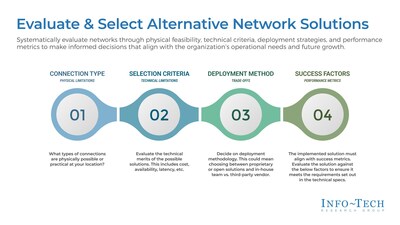Info-Tech Research Group’s latest blueprint provides key strategies for IT leaders evaluating and selecting network solutions, essential for organizations aiming to enhance connectivity and adapt to rapid technological changes. This research outlines actionable steps for optimizing network infrastructure, ensuring organizations are equipped for both current needs and future growth.
TORONTO, May 7, 2024 /PRNewswire/ – Digital transformation has quickly become a critical factor in market success, heightening the demand for reliable and secure digital connectivity. Consequently, selecting the right network solutions is more crucial than ever for organizations to thrive and gain a competitive advantage. Info-Tech Research Group’s latest blueprint, Evaluate and Select Alternative Network Solutions, provides IT leaders with timely guidance through the complexities of advanced networking technologies. This research will assist organizations with assessing and integrating alternative network solutions such as 5G and Low Earth Orbit (LEO) satellites, ensuring their network infrastructure is not only robust, but also primed for future technological advancements.
“The search for robust and scalable network solutions has become paramount. In the quest for cost efficiency, organizations might gravitate toward immediate, cheaper solutions. However, the true value lies in future-proofing,” says John Donovan, principal research director at Info-Tech Research Group. “Beyond traditional multiprotocol label switching (MPLS) and fiber optic connections, organizations are increasingly considering cellular networks, especially given the advancements in 5G, and innovative overlay solutions for enhanced connectivity and flexibility.“
Info-Tech’s latest findings emphasize the strategic integration of advanced network solutions into current IT infrastructures. This integration is crucial for organizations seeking to effectively leverage emerging technologies, such as 5G and LEO satellites. By adopting these advanced networking options, organizations can ensure greater operational agility and improved service reliability, which are essential for maintaining competitive advantage in the fast-paced digital economy.
“While criteria like speed, reliability, and cost remain pivotal, the added dimension of availability, especially with 5G’s widespread reach and LEO’s promise for remote areas, has become crucial,” explains Donovan. “Systems such as Starlink, OneWeb, and 5G networks are not only reshaping the standards for connection speeds but are also bridging global digital gaps with their expansive coverage. As the world grows more interconnected, the blend of these alternative and traditional solutions will dictate the future of global communications.“
When selecting alternative network solutions, Info-Tech advises organizations to embrace the principle that one size does not fit all. While there’s a natural inclination to adopt widely recognized solutions, it’s essential to match the unique operational demands of each organization with a tailored network approach, ensuring both optimal performance and cost-effectiveness in the long term.
Furthermore, the research explains that the journey toward implementing a new network solution isn’t solely about the technology’s prowess; it’s equally about the transition. A smooth migration, characterized by phased rollouts, staff training, and contingencies for unexpected challenges, can spell the difference between operational disruptions and a seamless shift to enhanced capabilities.
By systematically evaluating networks through the following four criteria outlined in the blueprint, organizations can make informed decisions that align with operational needs and future growth. The four criteria are:
- Connection Type – Physical Limitations
- Consider if the types of connections are physically possible or practical at the specified location.
- Physical – Examples: Fiber optic, ethernet
- Wireless – Examples: LTE, 5G
- Overlay – Examples: SD-WAN, VPN
- Satellite – Examples: LEO (e.g. Starlink), GEO
- Consider if the types of connections are physically possible or practical at the specified location.
- Selection Criteria – Technical Limitations
- Evaluate the technical merits of the possible solutions, including cost, availability, latency, etc.
- Cost – Balancing financial feasibility with performance.
- Availability – Ensuring consistent uptime and network reliability.
- Latency – Minimizing data transmission delays for real-time applications.
- Bandwidth – Providing adequate capacity for data-intensive transmission.
- Evaluate the technical merits of the possible solutions, including cost, availability, latency, etc.
- Deployment Method – Trade-Offs
- Decide on deployment methodology, which could mean choosing between proprietary or open solutions, as well as determining if an in-house team could manage deployment or if a third-party vendor is needed.
- Build (DIY)
- Benefits: More control, potentially cost-effective long term, customized for specific needs.
- Drawbacks: Requires expertise, upfront investment, and maintenance responsibilities.
- Buy (Outsourced)
- Benefits: Quick deployment, expertly managed, less internal responsibility.
- Drawbacks: Potentially higher costs, less customization.
- Build (DIY)
- Decide on deployment methodology, which could mean choosing between proprietary or open solutions, as well as determining if an in-house team could manage deployment or if a third-party vendor is needed.
- Success Factors – Performance Metrics
- The implemented solution must align with broader success metrics. Evaluate the solution against the below factors to ensure it meets the requirements set out in the technical specs.
- High throughput: Essential for data-intensive operations.
- Low latency: Crucial for real-time applications.
- Flexible and focused bandwidth allocation: Allows prioritizing of essential services.
- Always-on connectivity: Ensure uninterrupted operations.
- Affordability: Balance performance with budget.
- Quick service deployment: Enables agility in adapting to changing needs.
- The implemented solution must align with broader success metrics. Evaluate the solution against the below factors to ensure it meets the requirements set out in the technical specs.
Info-Tech explains in the new blueprint that selecting the right network solution is a strategic decision that involves weighing factors such as scalability, performance, and cost-effectiveness against emerging technological trends. By carefully assessing and selecting alternative network solutions, organizations can enhance connectivity and optimize their infrastructure to achieve current and future business demands and goals.
Investing in scalable and adaptable network solutions, even if they demand a higher initial cost, positions organizations to better accommodate growth and swiftly integrate with emerging technologies more effectively, ensuring long-term operational resilience and competitive advantage.
For exclusive and timely commentary on this topic from Info-Tech’s experts and access to the complete Evaluate and Select Alternative Network Solutions blueprint, please contact [email protected].
Registration is now open for Info-Tech Research Group’s annual IT conference, Info-Tech LIVE 2024, taking place September 17 to 19, 2024, at the iconic Bellagio in Las Vegas. This premier event offers journalists, podcasters, and media influencers access to exclusive content, the latest IT research and trends, and the opportunity to interview industry experts, analysts, and speakers. To apply for media passes to attend the event or gain access to research and expert insights on trending topics, please contact [email protected].
Info-Tech Research Group is one of the world’s leading research and advisory firms, proudly serving over 30,000 IT and HR professionals. The company produces unbiased, highly relevant research and provides advisory services to help leaders make strategic, timely, and well-informed decisions. For nearly 30 years, Info-Tech has partnered closely with teams to provide them with everything they need, from actionable tools to analyst guidance, ensuring they deliver measurable results for their organizations.
To learn more about Info-Tech’s divisions, visit McLean & Company for HR research and advisory services, and SoftwareReviews for software-buying insights.
Media professionals can register for unrestricted access to research across IT, HR, and software and hundreds of industry analysts through the firm’s Media Insiders program. To gain access, contact [email protected].
For information about Info-Tech Research Group or to access the latest research, visit infotech.com and connect via LinkedIn and X.
![]() View original content to download multimedia:https://www.prnewswire.com/news-releases/future-proofing-connectivity-info-tech-research-group-publishes-guide-to-selecting-alternative-network-solutions-302138862.html
View original content to download multimedia:https://www.prnewswire.com/news-releases/future-proofing-connectivity-info-tech-research-group-publishes-guide-to-selecting-alternative-network-solutions-302138862.html
SOURCE Info-Tech Research Group

Featured image: DepositPhotos © Rfphoto









